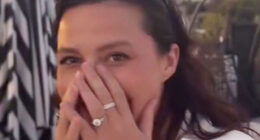‘I swear I saw faces in the darkness’: can you scare yourself happy?

From a walk in the woods at night to exploring a ghostly derelict building or riding a bloodcurdling rollercoaster, can a dose of fear make you forget your everyday worries?
‘Fifty feet, Danny!” Lucy shrieks as we ascend to the top of the Big One, the UK’s tallest rollercoaster. “One hundred feet … one hundred and fifty feet … two hun …” she continues. “OK, I get it; we’re high,” I reply. “Oh God, oh God, oh God! Aaaaaargh!” We scream as our carriage reaches the track’s apex and plummets back to Earth at 70mph.
I have come to Blackpool Pleasure Beach with a friend to try to scare myself happy. Fear is said to be as good for mental wellbeing as a dose of mindfulness. I am also hoping that exposing myself to acute fear will help me to cope with my terror of public speaking. After we exit the ride, everything appears a little sharper, colours seem brighter and sounds are crystal clear– rollercoaster Zen.
“One of my best friends is a yoga instructor and highly trained in meditation,” says Margee Kerr, the author of Scream: Chilling Adventures in the Science of Fear, over the phone from Denver, Colorado. “And we joke around, because we are trying to get to that same state via two different routes. She’s going through the focus meditation and I just scare myself. All of the rumination, all of that internal noise is muted, because the body is saying: ‘No, we need to focus our energy and resources on survival, so we’re just going to turn down all that inner dialogue and be here in the moment.’”
Kerr is a sociologist and her book is a science travelogue that explores fear and why people pursue it. In it, she rides extreme rollercoasters, braves supercharged “scare houses” (horror-themed walking tours where actors are employed to frighten visitors), stays overnight in an abandoned prison and braves the EdgeWalk at the CN tower, North America’s tallest skyscraper.

“I grew up a fan of horror movies and haunted houses and was a bit of a thrill-seeker,” Kerr says. “I think that’s what initially got me interested. And then also just trying to understand: why do people like to do scary things? Why do I like to do scary things?”
Well? “Oh, so many reasons,” Kerr says. “There is the physical high, the natural high. People talk about all the endorphins, adrenaline and changes that happen in the body when our sympathetic nervous system increases its activity and circulates all of these different hormones and neurochemicals that, in the right context, can make us feel strong and powerful.”
These benefits explain why certain therapies try to take people out of their comfort zones by exposing them to things that scare them. Exposure therapy is a psychological treatment designed to help patients confront the fears they have been avoiding in a safe environment. Kerr is working on making such therapies more fun in order to lower the dropout rate, which she says can be as high as 50%.
Some therapies take place in virtual-reality environments, such as a crowded train filled with hostile passengers in absurd costumes staring judgmentally at patients. “They’re not being told to try to calm down. They’re being told that they can scream, they can laugh. We start there and then work down to a subway car just full of humans. The idea is that, after you do a fun, scary experience, humans should not be as scary in comparison,” says Kerr.

Context is crucial, as fear and excitement share an identical physiological footprint; the only difference is how we frame experiences in our minds. Being confronted by a ravenous grizzly bear and being spun around on a rollercoaster will produce the same chemicals, but they are very different emotional experiences.
As long as you get your dose of fear in the right setting, you can reap its benefits. “These very intense emotional experiences can bring people closer together, especially if there’s already a positive bond between people in groups; it can strengthen that. And we form really strong memories when we’re doing something highly emotional, because we want to remember things that hurt us or that make us feel good.”
Kerr thinks that chronic, everyday fears – health concerns, worries about bills, making a social faux pas – may explain why we seek out more in-your-face threats: “I wonder if we sometimes really want that acute threat, because it is satisfying, in a way, to experience the fear – to experience all of that intensity and then relief. So, the joy comes after it’s over. There’s just that feeling of: ‘The threat has passed, I can relax.’”
The sympathetic nervous system handles the fight-or-flight response we experience during a threatening encounter, and the parasympathetic nervous system is responsible for the relief and sense of presence we feel after it has passed.
When Kerr braved the EdgeWalk, she leaned back into her harness on the edge of the 553-metre-tall building and into the Toronto sky. She “experienced her body in a totally new way” and became overwhelmed with fear. But that day is now a happy “keystone” memory for her – one she can draw on in times of stress. “I think about that moment and it inspires me. I think it taps into some type of physical memory, where I’m just remembering I can do this. And I love having that memory. I wish everybody could have a very intentional memory like that to give them strength.”
Inspired by Kerr’s bravery, I attempt to do as many frightening things as possible in the weeks after our conversation. Unfortunately, there is not enough research into how often one should experience acute fear to get the benefits of which Kerr speaks, but I would recommend doing something that scares you at least once in your life. It may make you feel terrifyingly good.
Rollercoasters

The UK’s tallest rollercoaster piques my interest, but ultimately leaves me unsatisfied. Surprise and a sense of jeopardy are more likely to produce Kerr’s “feargood factor” – and there is a different ride at the Pleasure Beach better suited to that. Icon twists, turns, loops and rolls like a drunken gymnast – it is awful and excellent.
My experience gets off to a bad start. Two staff members manage to convince me that my harness is insecure. One of them struggles to clip me in, but never mind – his colleague is coming over to sort it. He meanders over and barely touches the harness. “It’s ’reet,” he says with a wink – and we’re off.
All the blood leaves my face as Lucy and I hurtle out from the platform. “I’m going to die!” I say as I feel myself slip in my chair. I scream and scream and scream, which makes Lucy laugh and laugh and laugh. It is sod’s law that the soundtrack to my death is manic laughter. I don’t die, of course, and I feel calm when it is all over. But I think a cup of tea would have achieved the same effect.
Fear factor 5/5
READ RELATED: If You Meet Any of These 5 Criteria, You Need To Cut Back on Sugar
Pasaje Del Terror

People pay a lot of money for strangers to startle them in the dark, usually in labyrinthine corridors, where performers re-enact famous scenes from horror films.
I choose Pasaje Del Terror, also at the Pleasure Beach. Online reviewers promise terrific acting and big frights, so I feel anxious as Lucy and I enter the dark passage in tandem. To help me achieve maximum fear, Lucy nominates me to lead our cohort.
Maybe the actors’ timing is off, or the lack of real danger is taking the sting out of everything, but I am completely unmoved. Still, the women behind me got what they paid for: chills, thrills, adrenaline and screams, followed by hugs and kisses at the end, no doubt when their parasympathetic nervous systems were rewarding their bravery with loving chemicals.
Fear factor 2/5
Midnight in the woods

The author John Yorke claims that every story, scary or otherwise, can be reduced to a journey through the woods after dark – so that is what I take, only with a twist. In the middle of my midnight stroll through a slice of the Pennine Edge wood, I decide to sit on a fallen tree trunk and watch a horror film on my phone. It is not lost on me that I am the creepiest thing in the woods at that moment.
After the film, as I make my way out through the thicket, I swear I see faces in the darkness. My sympathetic nervous system is firing on all cylinders when I finally make it out to a quiet suburban cul-de-sac.
Fear factor 3/5
Climbing

Climbing ticks two major fear boxes for me: fear of heights and fear of falling.
It is a wet and foggy Saturday morning when I boulder up the side of Indian’s Head in Saddleworth, Greater Manchester, which resembles a Native American chief. I am utterly exhausted as I reach the rocks at the top. I have zero climbing experience, but the rocks are about 4.5 metres (15ft) high, so I don’t need a climbing rope, a harness or carabiners.
However, I begin to doubt whether this is true as I reach halfway up the rock I’ve chosen – the chief’s nose. I have run out of footholds and handholds and I am not confident enough to clamber down. So, I am left with two choices: dropping to the ground or clinging on until rescue comes.
I choose the former and press my torso to the rock face as hard as I can, to create as much friction as possible as I slide down and land firmly, but safely, on my feet, bruising my heels. A small price to pay, because, if I had staggered back just slightly, I would have tumbled down boulder city behind me.
I didn’t feel any benefits here, just scared and stupid. If I were you, I would find a climbing wall and an instructor.
Fear factor 5/5
Abandoned building

There is a burnt-out, abandoned mill at the bottom of a bridle path that runs adjacent to my home. It has a haunted Victorian quality to it, especially at night.
I am not scared of ghosts, mainly because they don’t exist – but even if they did, what is there to be afraid of? They can’t touch you, let alone harm you. The worst thing they can do is startle you and make you question your sanity. Being a ghost must be the worst form of the afterlife. Ghosts can be seen only at night by certain people in old houses and their raison d’etre is scaring silly people.
Still, the darkness and Victorian architecture make me feel as though someone is watching us. My brother and I enter what remains of the mill’s interior through a rotting wooden door and move steadily under torchlight around rusted, broken looms and displaced flagstones. There is loads of graffiti inside, “so we’re not the only ones to have come”, I say when I feel something tap me on my shoulder. That something turns out to be bat poo, but it doesn’t stop me from panicking and fleeing the mill as a colony of bats flutter above. Still, I am buzzing when we make it back to the bridle path.
Fear factor 4/5
Daniel Lavelle’s book, Down and Out: Surviving the Homelessness Crisis, is published by Wildfire (£18.99). To support the Guardian and the Observer, order your copy at guardianbookshop.com. Delivery charges may apply
Source: Health & wellbeing | The Guardian









